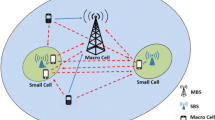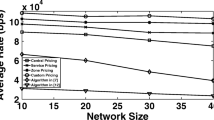Abstract
In this paper we study the joint rate-and-power allocation for multi-channel spectrum sharing networks with balanced QoS provisioning and power saving. We formulate this cross-layer optimization problem as a non-cooperative game G JRPA in which each user has a coupled two-tuple strategy, i.e., simultaneous rate and multi-channel power allocations. A multi-objective cost function is proposed to represent user’s awareness of both QoS provisioning and power saving. We analyze the properties of Nash equilibrium (N.E.) for our G JRPA , including its existence, and properties of QoS provisioning and power saving. Furthermore, we derive a layered structure by applying the Lagrangian dual decomposition to G JRPA and design a distributed algorithm to find the N.E.. Simulation results are presented to show the validity of our game theoretic formulation and the performance of our proposed algorithm. Detailed studies on the performance tradeoff between QoS provisioning and power saving are also carried out.







Similar content being viewed by others
Notes
Zhao et al. [1] classified the DSA mechanisms into three categories, i.e., exclusive usage mechanism, hierarchical access mechanism, and spectrum sharing mechanism.
Practically, \(R_{i}^{min}\) can be set as user i’s minimum data rate and \(R_{i}^{max}\) can be determined by user i’s maximum achievable data rate without considering the interference from other users. We assume in this paper that \(R_{i}^{min}<R_{i}^{tar}<R_{i}^{max},\forall i\in\mathcal {N},\) holds. \(pl_{i}^{k}\) and \(pu_{i}^{k}\) can be considered as user i’s spectrum mask bounds on channel k, which are specific to cognitive radio system [12].
We consider a relatively static network in this paper, i.e., the set of channel power gains \(g_{ji}^{k},\forall i,j\in \mathcal {N}, \forall k\in\mathcal {K}\) keeps unchanged during the time interval of interest.
In this paper, QoS provisioning is referred to achieving the target rate as exactly as possible.
In [11] the capacity region \(\mathcal {R}\) is defined as \(\mathcal {R}=\{(r_{1},...,r_{N})|r_{i}\leq \sum_{k\in\mathcal {K}}\mathit{\Phi}_{i}^{k}(p_{i}^{k},\mathbf{p}_{-i}^{k}),\forall i\in\mathcal {N};\mathbf{p}_{i}\in \mathit{\Omega}_{i}^{P},\forall i\in\mathcal {N}\}\).
\([x]_{a}^{b}\) denotes the projection of a real number x into the interval [a,b]. Similarly, [x] + denotes the projection of x into [0, ∞ ).
\(\|(A)\|_{2}\triangleq \max\{\sqrt{\lambda}:\lambda\) is an eigenvalue of A ∗ A} according to [19], where A ∗ denotes the conjugate transpose of matrix A.
According to [16], the mapping T(x) from a subset \(\mathcal {X}\) of ℝn to itself is contractive if it has the property that \(\|T(x)-T(y)\|\leq \varrho\|x-y\|,\forall x,y\in \mathcal {X}\) and the decay modulus \(\varrho\) belongs to [0,1). Besides, the contractive mapping x(t + 1) = T(x(t)) has a geometric convergence as \(\|x(t)-x^{*}\|\leq \varrho^{t}\|x(0)-x^{*}\|,\forall t\geq0\) assuming \(x^{*}\in\mathcal {X}\) is a fixed point.
Specifically, \(g_{ij}^{k}=d_{ij}^{-\tau}|\xi_{ij}^{k}|^{2}\), where d ij is the distance between TX i and RX j and we set τ = 2. \(\xi_{ij}^{k}\) is a complex Gaussian random variable modeling the frequency selective fading across the channels with distribution \(\mathcal {C}\mathcal {N}(0,1)\).
Relative error of power allocation is defined as \(\log_{10}\left(\frac{\|\mathbf{p}_{i}-\mathbf{p}_{i}^{\ast}\|_{2}}{\|\mathbf{p}_{i}^{\ast}\|_{2}}\right)\) and relative error of dual price is defined as \(\log_{10}\left(\frac{|z_{i}-z_{i}^{\ast}|}{z_{i}^{\ast}}\right)\). Both values are averaged over all the users.
References
Zhao Q, Swami A (2007) A survey of dynamic spectrum access: signal processing and networking perspectives. In: Proc IEEE ICASSP2007, Honolulu, April 2007
Scutari G, Palomar DP, Barbarossa S (2008) Optimal linear precoding strategies for non-cooperative systems based on game thoery—part I: Nash equilibria. IEEE Trans Signal Process 56(3):1230–1249
Etkin R, Parekh A, Tse D (2007) Spectrum sharing for unlicensed bands. IEEE J Sel Areas Commun 25(3):517–528
Jin T, Chigan C, Tian Z (2006) Game-theoretic distributed spectrum sharing for wireless cognitive raido networks with heterogeneous QoS. In: Proc. GLOBECOM2006, San Francisco, 27 November–1 December 2006
Yuan J, Yu W (2006) Distributed cross-layer optimization of wireless sensor network: a game theoretic approach. In: IEEE GLOBECOM2006, San Francisco, 27 November–1 December 2006
Scutari G, Barbarossa S, Palomar DP (2006) Potential games: a framework for vector power control problems with coupled constraints. In: Proc. ICASSP2006, Toulouse, 15–19 May 2006
Shum KW, Leung KK, Sung CW (2007) Convergence of iterative waterfilling algorithm for Gaussian interference channels. IEEE J Sel Areas Commun 25(6):1091–1100
Goldsmith AJ, Chua S-G (1997) Variable rate variabl power MQAM for fading channels. IEEE Trans Commun 45(10):1218–1230
Chiang M (2005) Balancing transport and physical layers in wirelss multihop networks, jointly optimal congestion control and power control. IEEE J Sel Areas Commun 23(1):104–116
Cendrillon R (2006) Optimal multiuser spectrum balancing for digital subscriber lines. IEEE Trans Commun 54(5):922–933
Suris JE, DaSilva LA, Han Z, Mackenzie AB (2007) Cooperative game theory for distributed spectrum sharing. In: Proc. ICC2007, Glasgow, 24–28 June 2007
Wang F, Krunz M, Cui S (2008) Price-based spectrum management in cognitive radio networks. IEEE J Sel Top Signal Process 2(1):74–87
Wu Y, Tsang DHK (2008) Joint rate-and-power allocation for multi-channel spectrum sharing networks. Technical Report, HKUST. http://eez058.ece.ust.hk/publication/yuanwu-techrept-0308.pdf
Osborne MJ, Rubinstein A (1994) A course in game theory. MIT, Cambridge
Basar T, Olsder GT (1999) Dynamic noncooperative game theory, 2nd edn. SIAM series classics in applied mathematics. SIAM, Philadelphia
Bertsekas DP, Tsitsiklis JN (1989) Parallel and distributed computation: numerical methods. Athena Scientific, Clermont
Boyd S, Xiao L, Mutapcic A (2003) Subgradient method. In: Lecture notes of EE392o. Stanford University, Stanford
Boyd S, Vandenberghe L (2004) Convex optimization. Cambridge University Press, Cambridge
Horn R, Johnson C (1999) Matrix analysis. Cambridge University Press, Cambridge
Author information
Authors and Affiliations
Corresponding author
Rights and permissions
About this article
Cite this article
Wu, Y., Tsang, D.H.K. Joint Rate-and-Power Allocation for Multi-channel Spectrum Sharing Networks with Balanced QoS Provisioning and Power Saving. Mobile Netw Appl 14, 198–209 (2009). https://doi.org/10.1007/s11036-008-0136-3
Published:
Issue Date:
DOI: https://doi.org/10.1007/s11036-008-0136-3




